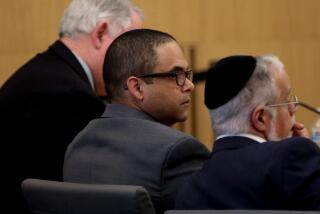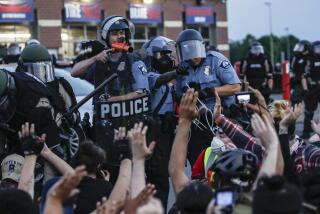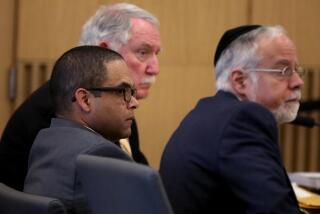Zimmerman murder trial: Officer describes Trayvon Martin’s death
One of the first police officers to reach the scene of the deadly confrontation between George Zimmerman and Trayvon Martin described trying to save the unarmed black teenager’s life with CPR as Martin lay face down on the ground with a bullet wound in his chest.
Police Sgt. Anthony Raimondo on Tuesday dramatically recalled his efforts at a gated community in Sanford, Fla., where Zimmerman shot Martin on the rainy night of Feb. 26, 2012.
Zimmerman, 29, who identifies himself as a Latino, is on trial, charged with second-degree murder in the shooting of Martin, a 17-year-old African American. Zimmerman says he shot Martin in self-defense after the youth attacked him.
PHOTOS: The controversial case in pictures
Raimondo, who was on patrol that night, told the jury he went to the scene after reports of shots fired. When he arrived, he said, he saw Martin on the ground and Zimmerman, handcuffed nearby.
The sergeant said Martin was not moving and did not make a sound. The officer said he bent down and tried to detect a pulse on Martin’s neck, but he found none. Then, he rolled Martin over onto his back.
“I breathed for Mr. Martin, or tried to,” he said, describing his mouth-to-mouth efforts as another officer began performing chest compressions on Martin. Asked whether Raimondo heard anything coming from Martin, he replied, “Bubbling sounds.”
‘“It meant either air was getting into or escaping from the chest in a manner it was not supposed to,” Raimondo testified.
GRAPHIC: Who’s who in the Trayvon Martin case
Raimondo called out to the gathering crowd to help by giving him plastic wrap and Vaseline to try to seal the chest wound. He said he lifted Martin into a sitting position to find the exit wound and seal it first, but he did not find the exit wound. Raimondo did, however, feel a cold can -- the soft drink Martin had just bought -- in the pocket of his hoodie.
After he could not find an exit wound, Raimondo said, he laid Martin back down and resumed CPR. Rescue workers arrived and hooked Martin up to an EKG machine, but the teenager was pronounced dead. Raimondo said he put a blanket over him, out of “respect for the deceased,” as well as to preserve evidence and to limit trauma to relatives who might come upon the scene.
Prosecutor John Guy showed Raimondo and the six-woman jury a photograph of Martin lying face-down in the grass, his hands underneath him. Close-up pictures of the bullet hole in Martin’s chest, in addition to the slain teenager’s face, hands, and the bloody hole in his shirt, were shown later when another witness testified.
When the graphic photographs were shown, Trayvon Martin’s father, Tracy, left the courtroom accompanied by a family lawyer, Daryl Parks, according to images broadcast from the Seminole County courtroom. Parks is seen returning to the courtroom and comforting Trayvon Martin’s mother, Sybrina Fulton.
Also shown to the jurors were photographs taken by police of Zimmerman’s balding head -- some bloody lacerations clearly visible -- and his face, with what appears to be a red cut on his nose.
Raimondo was the lead-off witness in what is expected to an extensive review of the physical evidence of the shooting. Zimmerman has apologized for shooting Martin and says he acted in self-defense when the teenager attacked him during a confrontation at the housing complex where Martin was staying with a friend of his father.
After Raimondo testified, the state called Diana Smith, a police crime scene technician, who described documenting evidence from the shooting scene.
In her testimony, Smith took the jurors through a diagram of that scene, then identified pieces of evidence she had collected. She told of the items she found with Martin, including candy, a soft drink and his cellphone.
ALSO:
Younger Americans still use public libraries, survey finds
Rusty the red panda escapes from National Zoo for a field trip
Texas students have strong opinions on affirmative action ruling
Twitter: @tinasusman
More to Read
Start your day right
Sign up for Essential California for news, features and recommendations from the L.A. Times and beyond in your inbox six days a week.
You may occasionally receive promotional content from the Los Angeles Times.








